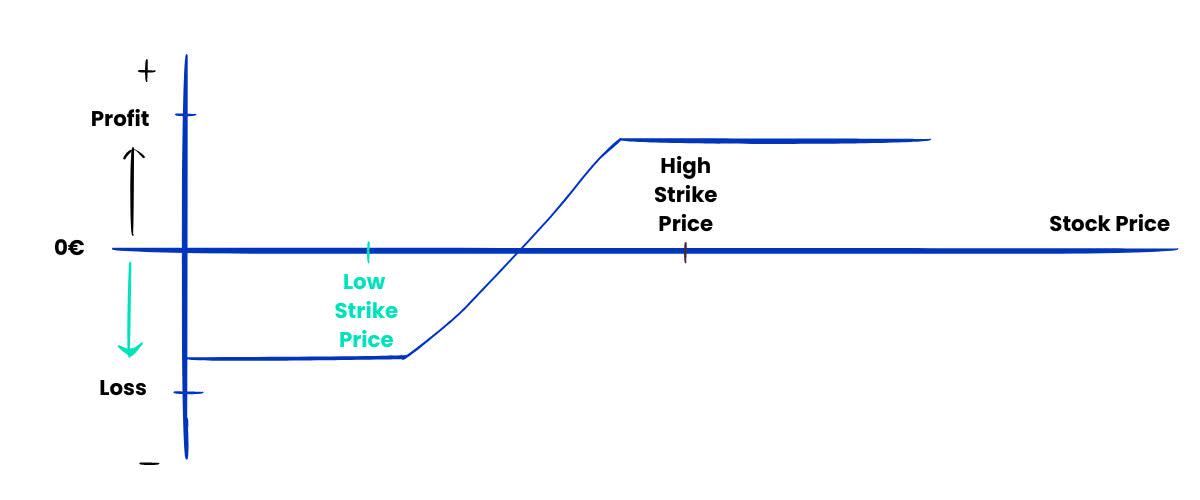Options reflect expectations about the underlying asset, and options are commonly priced using the Black-Scholes model:

N(d1) and N(d2) are probability functions, S is the spot (current) price of the asset, K is the strike price, r is the risk free rate, and T-t represents time to maturity. Without getting into the mathematics, it suffices to say that higher volatility or expectation of volatility increases the perceived riskiness of the asset, so call options are priced lower and put options are priced higher.
Think about it intuitively. If the stock is more likely to go downwards, then there's an increased chance that the call option expires worthless, so call options must be priced lower to accommodate the relative change in expected value of the option.
Puts are priced similarly, but they move inversely with respect to call option prices due to Put-Call parity. So if call option prices are falling, then put option prices are rising (Note, however, that call prices falling does not cause put prices to rise. The inverse relationship exists because of changes in the underlying factors and how pricing works.)
So the option action signifies that the market believes the stock is headed lower (in the given time frame). That does not mean it will go lower, and option traders assume risk whenever they take a particular position. Bottom line: gotta do your own homework!
Best of luck.
在本文中,我們將解釋什麽是牛市看漲價差 (spread),提供詳細的示例,討論其優點
和缺點,並回答一些常見問題。
什麽是牛市看漲價差 (spread)?
牛市看漲價差 (spread)是一種期權交易策略,旨在從標的資產價格適度上漲中利潤。
該策略涉及以較低的執行價格購買 看漲期權 ,同時以較高的執行價格出售另一份到
期日相同的看漲期權。主要目標是減少支付的淨溢價,從而降低交易成本。
牛市價差 (spread)限製了潛在利潤和潛在損失,最大利潤為執行價格減去淨支付的
權利金後的差額,最大損失則限製在淨支付的權利金以內。
牛市看漲價差 (spread)示例
為了更好地理解牛市看漲價差 (spread)的工作原理,讓我們考慮一個例子:
假設交易者認為 XYZ 公司的股票(目前交易價為 50 美元)近期將升至 60 美元。
交易者可以按如下方式實施牛市看漲價差 (spread):
- 購買執行價格為 50 美元的看漲期權,每股支付 5 美元的溢價。
- 出售看漲期權,執行價格為 60 美元,每股溢價 2 美元。
支付的淨溢價為每股 3 美元(支付 5 美元 - 收到 2 美元)。由於每個期權合約通常
代表 100 股,因此支付的淨溢價總額為 300 美元。
場景:
- 股票價格上漲至 60 美元以上: 兩種期權均被行使,交易者獲得最大利
- 潤。最大利潤為 700 美元 [(執行價差 10 美元 x 100 股)- 支付的淨
- 溢價 300 美元]。
- 股價保持在 50 美元至 60 美元之間: 買入的看漲期權升值,而賣出的
- 看漲期權抵消部分收益。如果股價超過 53 美元,利潤將低於最大值但
- 大於零。
- 股票價格仍低於 50 美元: 兩種期權均到期作廢,交易者損失已支付
- 的淨溢價,即 300 美元。
牛市價差 (spread)的優缺點
了解牛市看漲價差 (spread)的優點和局限性可以幫助交易者決定何時使用該策略。
| 優點 |
缺點 |
| 有限風險: 潛在損失僅限於預先知道的淨支付保費。 |
有限利潤: 最高利潤上限為執
行價格減去支付的淨溢價之間
的差額。
|
| 成本更低: 與購買單個看漲期權相比,賣出看漲期權可降低交易的總成本。 |
複雜性: 比簡單地買入或賣
出單一期權更複雜。
|
| 從適度上漲中利潤: 允許交易者從標的資產價格適度上漲中利潤。 |
保證金要求: 由於看漲期權
的風險,這可能需要大量的保證金。
|
概括
對於預期標的資產價格溫和上漲的交易者來說,牛市看漲價差 (spread)是一種有用的策略。通過了
解如何實施和管理這一策略,交易者可以限製風險,同時從市場上漲中獲利。將牛市看漲
價差與其他期權策略例如熊市看漲價差進行比較,有助於交易者根據其市場前景選擇最合
適的策略。
常見問題解答
1. 什麽是牛市看漲價差 (spread)?
牛市看漲價差 (spread)是一種期權策略,涉及以較低的執行價格買入看漲期權並以較高
的執行價格賣出另一個看漲期權,以從標的資產價格適度上漲中利潤。
2. 牛市看漲價差 (spread)如何運作?
該策略要求支付淨溢價來建立交易,最大利潤為執行價格減去支付的淨溢價之間的差額。
最大損失僅限於支付的淨溢價。
3. 牛市價差 (spread)的優點和缺點是什麽?
優點包括風險有限、與購買單個看漲期權相比成本較低,以及能夠從適度的價格上漲中
利潤。缺點包括利潤有限、複雜性和潛在的保證金要求。
4. 為何要用Skilling交易期權?
Skilling 中的 交易期權 提供高級工具、低費用和教育資源,以增強您的交易策略。了解
有關使用 Skilling 進行 CFD 交易的更多信息,以多樣化您的交易機會。例如,了解 鉑
金價格 可以幫助您在交易 商品 時做出戰略交易決策。但是,過去的表現並不代表未來
的結果,交易也存在風險。













